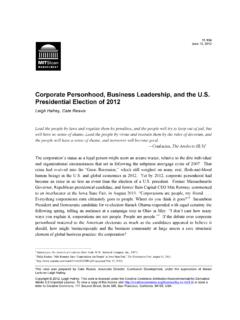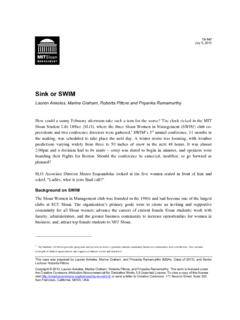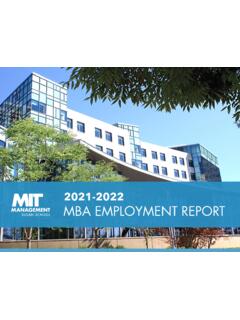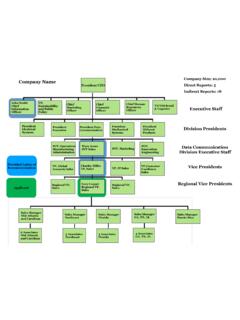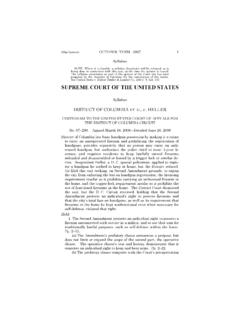Transcription of The Financial Crisis of 2008.IC - MIT Sloan School of ...
1 This case was prepared by Cate Reavis under the supervision of Deputy Dean JoAnne Yates. Copyright 2009, Massachusetts Institute of Technology. This work is licensed under the Creative Commons Attribution-Noncommercial-No Derivative Works Unported License. To view a copy of this license visit or send a letter to Creative Commons, 171 Second Street, Suite 300, San Francisco, California 94105, USA. 09-093 Rev. march 16, 2012 The Global Financial Crisis of 2008 : The Role of Greed, Fear, and Oligarchs Cate Reavis Free enterprise is always the right answer. The problem with it is that it ignores the human element. It does not take into account the complexities of human Andrew W. Lo, Professor of Finance, MIT Sloan School of Management; Director, MIT Laboratory of Financial Engineering The problem in the Financial sector today is not that a given firm might have enough market share to influence prices; it is that one firm or a small set of interconnected firms, by failing, can bring down the Simon Johnson, Professor of Entrepreneurship, MIT Sloan School of Management; Former Chief Economist, International Monetary Fund On October 9, 2007, the Dow Jones Industrial Average set a record by closing at 14,047.
2 One year later, the Dow was just above 8,000, after dropping 21% in the first nine days of October 2008 . Major stock markets in other countries had plunged alongside the Dow. Credit markets were nearing paralysis. Companies began to lay off workers in droves and were forced to put off capital investments. Individual consumers were being denied loans for mortgages and college tuition. After the nine-day stock market plunge, the head of the International Monetary Fund (IMF) had some sobering words: Intensifying solvency concerns about a number of the largest and European Financial institutions have pushed the global Financial system to the brink of systemic meltdown. 3 1 Interview with the case writer, April 10, 2009. 2 Simon Johnson, The Quiet Coup, The Atlantic, May 2009. 3 IMF in Global Meltdown Warning, BBC News, October 12, 2008 . THE GLOBAL Financial Crisis OF 2008 : THE ROLE OF GREED, FEAR, AND OLIGARCHS Cate Reavis Rev.
3 march 16, 2012 2 By early 2009, the markets had stabilized to the point where the stock market was no longer down 700 points one day and up 500 the next. In May, the results of the stress tests conducted on the 19 largest banks in the United States to test their capacity to withstand a further economic downturn were less negative than feared, with 10 out of the 19 subjected to the test ordered to raise $75 billion in new capital. A number of the banks that were told to raise additional capital saw their stocks rise sharply on the day the results were released, with Wells Fargo up 24% and Bank of America up 19%.4 Despite the seemingly improved situation, academics, practitioners, and politicians alike were debating how we got to where we were, and what to do in both the short and long term to bring more lasting order to the chaos and prevent the same level of turmoil the next time a Financial Crisis hit. That there would be a next time was indisputable in the eyes of Andrew Lo, a professor of finance at the MIT Sloan School of Management and the director of MIT s Laboratory of Financial Engineering.
4 In fact, since 1974, 18 bank crises had occurred around the world, and each shared something in common: a period of great Financial liberalization and prosperity that preceded the Crisis . As Lo remarked in his November 2008 testimony before the House Oversight Committee Hearing on Hedge Funds, Financial crises may be an unavoidable aspect of modern capitalism, a consequence of the interactions between hardwired human behavior and the unfettered ability to innovate, compete, and evolve. 5 Simon Johnson, a professor of entrepreneurship at the MIT Sloan School of Management and former chief economist at the IMF from 2007 to 2008 , believed that the current Crisis was caused by powerful elites, what he called a banking oligarchy that overreached in good times and took too many risks. As he wrote in an article for The Atlantic, Elite business interests played a central role in creating the Crisis , making ever-larger gambles, with the implicit backing of the government, until the inevitable collapse.
5 6 Understanding what, how, and why the Crisis happened was a critical part of the process to stabilize the Financial system in the short term and soften the blow of the next Financial Crisis . Johnson and Lo were actively involved in finding those solutions. Whether they were advocating the right solutions and whether such solutions could or would be implemented remained unknown. What also remained unknown was whether their solutions aptly addressed what David Beim, a finance professor at Columbia Business School , believed was at the heart of the problem: 4 Damian Paletta and Deborah Solomon, More Banks Will Need Capital, The Wall Street Journal, May 5, 2009. 5 Andrew W. Lo, Hedge Funds, Systemic Risk, and the Financial Crisis of 2007 2008 : Written Testimony for the House Oversight Committee Hearing on Hedge Funds, November 13, 2008 , p. 1. 6 Simon Johnson, The Quiet Coup, The Atlantic, May 2009. THE GLOBAL Financial Crisis OF 2008 : THE ROLE OF GREED, FEAR, AND OLIGARCHS Cate Reavis Rev.
6 march 16, 2012 3 The problem is not the banks, greedy though they may be, overpaid though they may be. The problem is us. We have been living very high on the hog. Our standard of living has been rising dramatically over the last 25 years, and we have been borrowing to make much of that prosperity happen. We have over-borrowed, and we have done that over many, many decades. And now it s reached just an unbearable peak where people on average cannot repay the debts they ve What Happened From a macroeconomic perspective, the collapse of the housing market triggered the Financial Crisis that began in As Johnson explained, the erosion of the housing market led to an erosion of wealth: What is on everyone s minds is this big loss of wealth. We had stocks that are now worth 50% less than what they were worth. We owned houses that have fallen substantially in value. The point is that people were banking on these assets having a certain value.
7 And that has implications for how much they were willing to consume and if they were firms how much they were willing to Few ordinary investors believed that the housing market would ever crash. For many years, real estate was considered one of the safest and most profitable investments. From the late 1990s into the mid-2000s, housing prices around the country rose at a compound annual growth rate of 8%. By 2006, the average home cost nearly four times what the average family made. (Historically, it had been between two to three ) Demand was outstripping supply. Even though household incomes remained flat during this time (Figure 1), more and more people were able to afford houses due to an easing of lending requirements that began in the Clinton administration and continued into the Bush administration. High-risk loans, including subprime mortgages given to people with troubled credit, fueled the growth.
8 In fact, the housing boom from the late 1990s into the mid-2000s drove much of the economy, adding jobs in construction, remodeling, and real estate services. Consumers feasted on the equity in their homes, taking out a total of $2 trillion via loans, refinancings, and The ratio that measures household debt to GDP doubled from 50% in the 1980s to 100% of GDP by the mid-2000s. The last time the level of debt was 100% of GDP was 1929, the beginning of the Great 7 Ira Glass, Adam Davidson, and Alex Blumberg, Bad Bank, NPR: This American Life, February 27, 2009. 8 For a more in-depth explanation of the Financial Crisis , see the blog 9 Terry Gross, Simon Johnson On Bank Bailout Plan, NPR: Fresh Air, march 3, 2009. 10 Ben Steverman and David Bogoslaw, The Financial Crisis Blame Game, BusinessWeek, October 18, 2008 . 11 Shawn Tully, Welcome to the Dead Zone, Fortune, May 5, 2006. 12 Ira Glass, Adam Davidson, and Alex Blumberg, Bad Bank, NPR: This American Life, February 27, 2009.
9 THE GLOBAL Financial Crisis OF 2008 : THE ROLE OF GREED, FEAR, AND OLIGARCHS Cate Reavis Rev. march 16, 2012 4 Figure 1 Growth of Housing Prices versus Household Income, 1991 2007 Source: S&P/Case-Shiller National Home Price Indices; Census Bureau. By 2006, it was evident that the housing bubble was starting to burst. People began defaulting on their mortgages, sending a ripple effect throughout the Financial system. As more people defaulted and went into foreclosure, more houses came on the market and precipitously pushed down housing prices (Figure 2). Figure 2 Housing Prices, 1990 2008 (adjusted for inflation) Source: S&P/Case-Shiller National Home Price Indices. As prices began to fall and the loan default rate began to rise, big Wall Street firms stopped gobbling up the riskier mortgages, which at one time had been extremely lucrative. Smaller banks and mortgage companies were left saddled with loans that they had borrowed money to buy in the first place and now could not sell.
10 Suddenly, banks started defaulting on their loans as well, triggering the downward spiral that by late 2008 gripped the world economy. Many banks were facing insolvency: $0$50,000$100,000$150,000$200,000$250,00 0$300,0001990199119921993199419951996199 7199819992000200120022003200420052006200 72008$149,752$171,421$261,739$180,100-15 -10-5051015% GrowthHous ingPricesHous eholdInc om eHousing ehold Inc om GLOBAL Financial Crisis OF 2008 : THE ROLE OF GREED, FEAR, AND OLIGARCHS Cate Reavis Rev. march 16, 2012 5 Their assets were too small to cover their liabilities, which meant that they owed more money than they had. Credit markets started to freeze up, and individuals and businesses alike could not get This was more or less the simplistic macroeconomic explanation. But Andrew Lo believed that the Crisis was about more than economic forces. In his mind, a human element was at play, most notably the emotions of greed and fear of the unknown.
